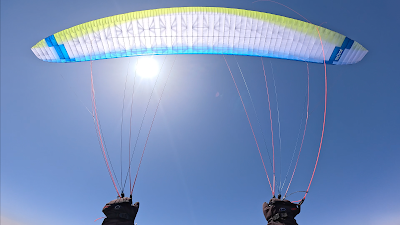NOVA Vortex XS, Light 2 liner EN-C
After a few modifications on their EN-C Codex with its normal cloth glider, NOVA released a light 2 liner with the same aspect ratio of 6.1
I flew the XS size that goes from 70-95 with a recommended weight of 80-90. Here’s the link: https://www.nova.eu/en/gliders/vortex/#c16770
After some hours flying the Vortex with different harnesses ( Arrow-P, Nearbirds Zippy 3, Normal Arrow), I think the Vortex is easy to fly in all harnesses with a mild character.
Of course, you know me well, that I like to fly my gliders well loaded, I felt that at 90..92, I could get the best out of the Vortex in all conditions. It could be flown easily at its recommended weight range, but if you want a taught glider with immediate response and forward drive through a heavy airmass, then flying the Vortex at 90..91 is great.
Launching that beautiful butterfly is super easy and flawless for a 2 liner. No shooting forward, just smooth inflation. When you kite the glider, you already feel and understand what to expect in the air from the movements and ability to be balanced overhead.
Launching at 91 all up is straightforward. First lift the Vortex has a neutral pitch and goes through thermals smoothly without a pitch back or forward. The brake pressure when inducing a turn is on the moderate side, with a moderate length. You need around 25 cm to pull for a turn, but…with a linear response, meaning that you pull 2cm, the glider reacts, but it is still long and forgiving. It is possible to core narrow cores while enjoying every moment! The feedback comes from the risers, not the brakes.
One day, I flew that glider in strong air and punchy lifts. I was happy that I flew it around 91..92 all up. The Vortex loaded in those conditions, felt completely like a docile 2 liner C! A first 2 liner from the B class is possible and welcomed. In turbulent air, the roll movements are tamed for a 2 liner C and as easy as on a 3 liner C (Artik7 P, for example). The A7 P that I still have over here, and fly in comparison, has shorter brakes and slightly sharper movements. The Vortex, being a 2 liner, doesn’t play in the same field of accessibility, perhaps a slight more control, but negligible…I’m only talking about pilot requirements for flying accessibility, not behavior after collapses, which I also didn’t experience when flying both gliders.
Comparing the handling with an Ozone Lyght size S (65-85) flown at 85, the Lyght has a slightly shorter brake response for the same agility. Of course, the pilot level required to fly the Lyght is slightly above the Vortex, which seems like a lamb in comparison.
Both the Codex and the Vortex offer the same comfort.
Climbing next to the best 2 -liner Cs for reference, showed me that in weak climb and strong, the Vortex has good acceptable capabilities. ( I will update my C comparison for that)
Doing some long glides with my reference glider, I saw a big potential in gliding power, mostly in calm air. The other 6.5, 2 liner machines had a slight advantage in a moving airmass. But for me, the Vortex was more than needed if I’m not racing toward a goal at full bar, or competing with a Lyght or Photon for the serial class. The Vortex got me everywhere I needed to be with a more comfortable ride and, most importantly, a light package!
The B handles are slightly on the firm side, but ok for the XS size I'm flying.
Ears are best done with outer A’s , because they are stable with an efficient sink rate! Playing around is fun, and the energy stored is high.
Conclusion:
The Vortex, with its light construction, compact packing, easy handling, and great maneuverability, offers an excellent package of accessible performance. for any (2-liner C class ) pilot going the light direction, especially for hike and fly, and of course, travellers! For the majority of pilots, the 70 L outside bag containing a glider/harness/helmet will weigh from 7 to 8 kg, depending on your harness and rescue! That’s quite fun to have.
Wishing everyone happy, safe flights and a beautiful summer!



